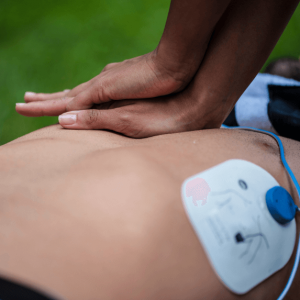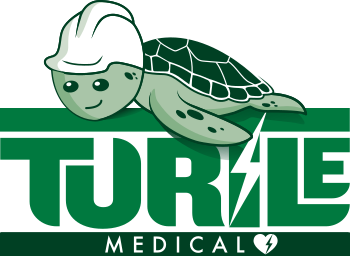
Knowing how to use an Automated External Defibrillator (AED) can make the difference between life and death. AEDs are crucial devices designed to provide a shock to the heart during a sudden cardiac arrest. This blog will guide you through the steps to use an AED, ensuring you’re prepared to act confidently and effectively in an emergency.
Understanding AEDs: What Are They?
An AED, or Automated External Defibrillator, is a portable electronic device that automatically diagnoses life-threatening cardiac arrhythmias and treats them through defibrillation. This process involves delivering a dose of electric current to the heart. AEDs are designed to be simple and user-friendly, enabling bystanders with minimal training to provide lifesaving assistance.
Why AEDs Are Essential
Sudden cardiac arrest (SCA) is a leading cause of death globally, often occurring without warning. When a person suffers an SCA, their chances of survival decrease by 10% with every minute that passes without intervention. AEDs significantly improve the chances of survival by restoring a regular heart rhythm if used promptly.
Recognising When to Use an AED
Before using an AED, it’s vital to recognise the signs of sudden cardiac arrest. These include:
- Sudden collapse
- No pulse
- No breathing
- Loss of consciousness
If you encounter someone exhibiting these symptoms, acting quickly is crucial. Call emergency services immediately and prepare to use an AED.
How to Use an AED: Step-by-Step Guide
Step 1: Ensure Safety
Before using an AED, make sure the area is safe for both you and the victim. Check for hazards such as traffic, electrical dangers, or unstable surroundings.
Step 2: Call Emergency Services
After performing a primary survey and finding someone unresponsive and not breathing normally, ask a helper to call 999 or 112 for an ambulance while you start CPR. If a defibrillator is available, ask the helper to retrieve it. If you’re alone, put your phone on speaker to call for help whilst performing CPR.
Step 3: Prepare the AED
As soon as the AED arrives, have the helper turn it on. Most AEDs have a power button, while others activate once the case is opened. Follow the verbal and visual instructions provided by the AED.
Step 4: Expose the Chest
Expose the victim’s bare chest by getting your helper to cut through any clothing. If the chest is wet, dry it thoroughly before placing the pads.
Step 5: Attach the Pads
Remove the backing paper from the AED pads and place them on the victim’s chest without stopping CPR compressions.
- Place the first pad on the upper right side below the collarbone.
- Place the second pad on the left side below the armpit.
Some pads have a sensor that goes under the hands of the person performing chest compressions. If using these, briefly stop compressions to place the sensor.
Step 6: Follow AED Prompts
The AED will instruct you to stop CPR to analyse the heart rhythm. Ensure no one is touching the victim during this time. The device will then give visual and verbal prompts for the next steps.
Step 7: Deliver the Shock if Needed
If the AED determines a shock is necessary, ensure everyone stands clear of the victim. The AED will either tell you to press the shock button or automatically deliver the shock if it’s a fully automated device. After the shock, resume CPR immediately as instructed.
Step 8: Continue CPR
Whether or not a shock was delivered, continue CPR for two minutes before the AED re-analyses the heart rhythm. Follow any further instructions from the AED.
Step 9: Monitor the Victim
If the victim shows signs of consciousness or responses, such as coughing, opening their eyes, speaking, or normal breathing, stop CPR and place them in the recovery position. Leave the AED attached and continue to monitor their condition. Be prepared to restart CPR if necessary.
Using an AED on Children, Pregnant Women, and Special Cases
Children
When using an AED on a child (under eight years or weighing less than 25 kg), it’s essential to use paediatric pads if available. These pads are designed to deliver a lower energy dose appropriate for a child’s heart. If paediatric pads are unavailable, you can use adult pads, but ensure they do not touch each other. Place one pad in the centre of the child’s chest and the other on their back, between the shoulder blades.
Pregnant Women
Using an AED on a pregnant woman follows the same procedure as for any other adult, apart from ensuring that the second pad is below the breast. It’s crucial to act quickly, as the survival of both the mother and the baby depends on it. There are no contraindications to using an AED on a pregnant woman, and it’s vital to follow the standard steps to ensure the best chance of survival.
Special Cases
For individuals with implanted medical devices such as pacemakers or defibrillators, place the AED pads at least an inch away from the device. If the person has a medication patch on their chest, remove it and wipe the area clean before attaching the AED pads.
Frequently Asked Questions About AEDs
Can Anyone Use an AED?
Yes, AEDs are designed to be used by anyone, even those without medical training. The devices provide clear, step-by-step instructions to guide users through the process.
Where Can I Find AEDs?
AEDs are commonly found in public places such as airports, shopping centres, schools, and sports venues. Look for AED signs indicating their location.
Do I Need Training to Use an AED?
While AEDs are user-friendly and require no formal training, attending a first aid or CPR course that includes AED use is highly beneficial. These courses provide hands-on experience and build confidence to handle emergencies effectively in critical situations.
Are AEDs Safe to Use?
Yes, AEDs are safe to use. They are designed to analyse the heart rhythm and only deliver a shock if it is necessary. They will not harm the victim if used correctly.
Be Prepared to Save a Life
Knowing how to use an AED can be the difference between life and death during a sudden cardiac arrest. By understanding the steps to use an AED and recognising the signs of sudden cardiac arrest, you can act swiftly and confidently in an emergency. Remember, every minute counts, and your actions can save a life. That’s why we offer on-site training so your team can stay prepared.
If you’re interested in buying an AED we offer a comprehensive range. We also provide Defibrillator Cabinets to keep your AED protected, and accessible.
